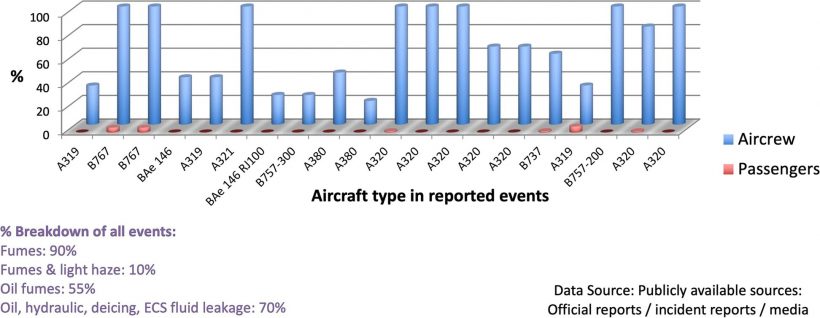
A group of world leading health and scientific experts are calling on the aviation industry to take action to protect passengers and aircrew from dangerous cabin fumes which they say have led to a new emerging disease.
Led by former pilot and leading global aviation health researcher Dr. Susan Michaelis, the specialists have released the first medical protocol of its kind to help treat those effected by contamination of the aircraft cabin breathing air supply and collect data on contamination events.
The International Fume Events Task Force, made up of 17 doctors, occupational health specialists, toxicologists, epidemiologists and aviation experts, have spent six years researching and preparing the evidence and guidance. The result is a unique protocol for medical staff and non-medically trained airline staff which outlines the actions and investigations they should carry out when a person has been exposed to fumes or fume events.
Aircrew and passengers are exposed to chronic background low-levels of engine oils and hydraulic fluids leaking into the aircraft air supply during every flight. They can also experience adverse effects from more irregular ‘fume’ events, which mark incidents when there’s a noticeable level of contaminants in the cabin.
Dr. Michaelis, who is an Honorary Senior Research Fellow at the University of Stirling, said, “This has been happening for the last 70 years and reports of air crew becoming unwell continue to rise.”
“Currently, when aircrew or passengers become unwell, whether they are still on the plane, suffer symptoms in the days or weeks to come, or report illness in the years that follow, there’s nothing in the medical books, there’s no guidance material for the aviation industry or medical professionals and very often they get turned away or are given minimal testing.”
“This new medical protocol has been written by internationally recognized experts and presents a consensus approach to the recognition, investigation and management of people suffering from the toxic effects of inhaling thermally degraded engine oil and other fluids contaminating the air conditioning systems in aircraft, and includes actions and investigations for in-flight, immediately post-flight and late subsequent follow up.”
“All of the data and evidence collected strongly suggests a causal connection between the contaminants from the oils and hydraulic fluids and people becoming unwell. This is the first comprehensive and systematic approach for documenting and gathering further epidemiological data in what is a discreet and emerging occupational health syndrome.”
The medical protocol and an accompanying narrative review have been published in Environmental Health.
The narrative review illustrates the diffuse and consistent pattern of adverse effects, as documented by aircrew and some passengers, after breathing these fumes onboard and incorporates the findings from fume event reports and documented ill health effects that were collected over decades in multiple countries and regions.
Professor Andrew Watterson of the University of Stirling said, “This is a globally important and ground-breaking study using a narrative review of a significant and complex problem for those exposed to aircraft cabin air supply fumes that result in a range of often serious adverse effects.”
“It has generated a very useful tool in the process, based on recent research, in the form of a protocol for identifying, assessing and better documenting those effects in the future.”
Exposure to aircraft contaminated air and fume events is associated with documented aircrew impairment and incapacitation, jeopardizing the safety of the flight. These exposures are known to cause foggy thinking, dizziness, fatigue and impaired short-term memory and cognitive thinking. It can also cause neurological, respiratory and cardiac complaints, while other studies have drawn links with various cancers.
More information:
Jonathan Burdon et al, Health consequences of exposure to aircraft contaminated air and fume events: a narrative review and medical protocol for the investigation of exposed aircrew and passengers, Environmental Health (2023). DOI: 10.1186/s12940-023-00987-8
Journal information:
Environmental Health
Source: Read Full Article






